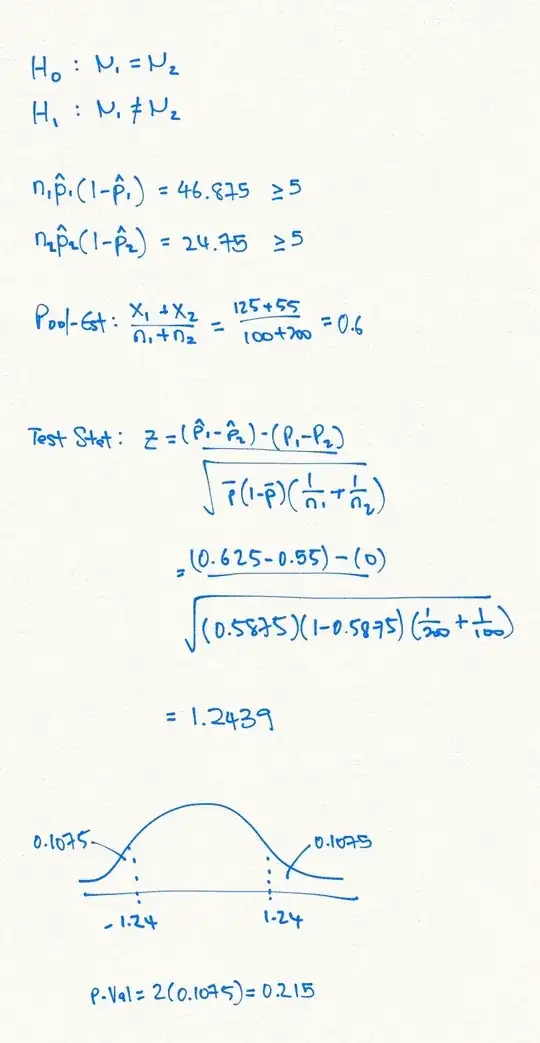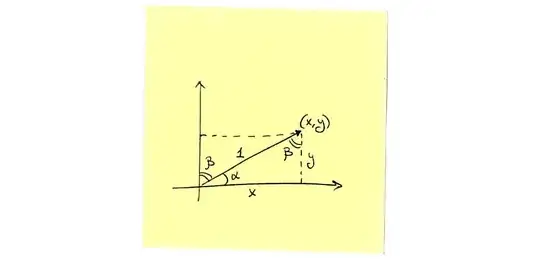I would like to multiply two correlated random variables, but I'm getting a negative variance. Please point out where I'm wrong.
Variable1 and Variable2 are projected onto data2 from a model trained on data1. The equation I am trying to use to calculate the variance of their products is from Variance of product of dependent variables. But when I translate it into R I get:
> data2$ProductVariance <- cov(data1$Variable2^2, data1$Variable1^2, use = "na.or.complete") + (data2$Variable2.se^2 + data2$Variable2^2)*(data2$Variable1.se^2 + data2$Variable1^2) - (cov(data1$Variable2, data1$Variable1, use = "na.or.complete") + data2$Variable2*data2$Variable1)^2
> data2[c(1, 50, 100, 150, 200), c("Variable1", "Variable1.se", "Variable2", "Variable2.se", "ProductVariance")]
Variable1 Variable1.se Variable2 Variable2.se ProductVariance
2 102.32145 0.4053362 0.68919721 0.006114099 -3.649645
60 103.55957 0.5298381 0.66190120 0.006577132 -3.528850
120 99.81072 0.4176735 0.07347951 0.005274879 -3.735716
183 100.59532 0.4008085 0.62787019 0.005122185 -3.777981
246 102.27556 0.3762328 0.73455316 0.006578060 -3.597734
Their covariance and squared-covariance are:
> cov(data1$Variable2, data1$Variable1, use = "na.or.complete")
[1] 0.0008326011
> cov(data1$Variable2^2, data1$Variable1^2, use = "na.or.complete")
[1] -4.00164
And, broken out by term, it looks like the negatives are coming from the 1st and 3rd term.
> data2$FirstTerm <- cov(data1$Variable2^2, data1$Variable1^2, use = "na.or.complete")
> data2$SecondTerm <- (data2$Variable2.se^2 + data2$Variable2^2)*(data2$Variable1.se^2 + data2$Variable1^2)
> data2$ThirdTerm <- -(cov(data1$Variable2, data1$Variable1, use = "na.or.complete") + data2$Variable2*data2$Variable1)^2
> data2[c(1, 50, 100, 150, 200), c("Variable1", "Variable1.se", "Variable2", "Variable2.se", "ProductVariance", "FirstTerm", "SecondTerm", "ThirdTerm")]
Variable1 Variable1.se Variable2 Variable2.se ProductVariance FirstTerm SecondTerm ThirdTerm
2 102.32145 0.4053362 0.68919721 0.006114099 -3.649645 -4.00164 4973.49137 -4973.1394
60 103.55957 0.5298381 0.66190120 0.006577132 -3.528850 -4.00164 4699.16893 -4698.6961
120 99.81072 0.4176735 0.07347951 0.005274879 -3.735716 -4.00164 54.06632 -53.8004
183 100.59532 0.4008085 0.62787019 0.005122185 -3.777981 -4.00164 3989.61583 -3989.3922
246 102.27556 0.3762328 0.73455316 0.006578060 -3.597734 -4.00164 5644.57031 -5644.1664
Have I misunderstood the formula?
EDIT
Should
> cov(data1$Variable2^2, data1$Variable1^2, use = "na.or.complete")
[1] -4.00164
be positive?

